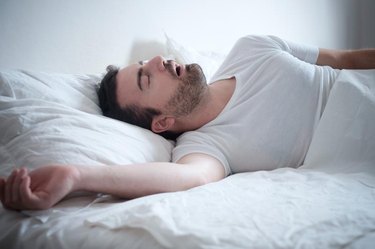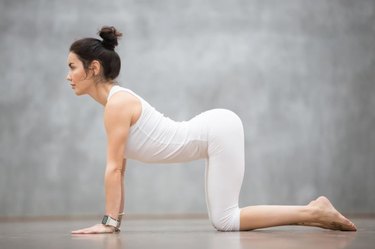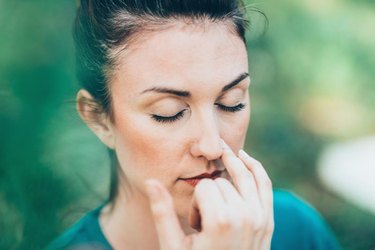
The National Sleep Foundation recommends you get between seven and nine hours of sleep per night. Even if you can manage to squeeze in these hours, interruptions in your sleep from sleep apnea interfere with quality shuteye. Sleep apnea is when you experience pauses in your breathing that last from just a few seconds to several minutes. The pauses disrupt deep sleep and can occur 30 or more times per hour.
Conventional ways to treat the condition include losing weight, changing your sleeping position, quitting smoking, treating allergies and avoiding alcohol and certain prescription drugs. Yoga is a non-invasive way to potentially help relieve the symptoms of sleep apnea, too.
Video of the Day
Video of the Day
How Yoga Helps
Sleep apnea usually happens because your airway gets blocked as you sleep and your breath becomes shallow or pauses as a result. The blockage can happen for a number of reasons, including your genetic neck structure, sleeping position, tonsil size, excess fat or poorly developed muscles of the throat and diaphragm. Yoga teaches you how to breathe fully and into your diaphragm; many Westerners breathe only into their chests. A regular practice means this deeper, more quality breath becomes second nature and carries over into sleep.
Certain yoga poses also help alleviate habitual stiffness in the neck, shoulders and back that sometimes lead to compression of the airway as you sleep. Stretching everything out makes more open sleep patterns come naturally, alleviating sleep apnea.
Of course, yoga is no substitute for medical support if your sleep apnea is severe. Always consult with your health care provider for advice as to whether your conditions is severe enough to require a CPAP or surgery.
Read More: Throat Exercises for Sleep Apnea
Poses
Simple poses that lengthen you and stretch out your spine promote better sleep positions. The following poses are appropriate any time of day, including before bed.
Cow/Cat: Get into all fours. Inhale and drop your belly toward the floor as you lift your collarbones and tailbone. Exhale and arch your spine dramatically, tucking your chin slightly. Alternate the two postures for about 10 breaths.

Locust: Lie flat on your belly with your legs extended and arms alongside your hips. Inhale and lift your face, chest, arms and legs up off the floor. Feel your spine lengthen as you lift and squeeze your legs toward each other. Hold for three to five breaths and lower back down.
Seated Twist: Sit in a comfortable cross legged position with your shoulders balanced over your hips. Inhale and straighten your spine; exhale and twist to the right, placing your right hand on the floor behind you and your left hand outside your right thigh. Inhale back to center and repeat on the other side.
Breath Work
Yoga breathing also offers possible relief to sleep apnea sufferers. Ujjayi breath helps clear your respiratory tract and strengthens your breathing muscles. Ujjayi breath is done in and out through the nose, with a slight constriction at the back of your throat. As you inhale, it's as if you were yawning with your mouth closed; as you exhale it's as if you were trying to steam up a window, also with your lips sealed.
Inhale and exhale retention are other breath-strengthening measures borrowed from yoga. For an inhale retention, simply inhale deeply and when you feel full of air, pause for three to five counts and then slowly exhale. Exhale retention involves inhaling and exhaling slowly and pausing at the bottom of the exhale — when you feel empty — for three to five counts. Both techniques should be performed in a measured, intentional manner.

Alternate nostril breathing is another yoga technique valuable to those with sleep apnea. To perform it, sit comfortably and place your first right two fingers on your forehead. Close off the left nostril with your right ring finger and inhale deeply through the right side. Close off the right nostril with your right thumb, release the left nostril and exhale completely. Inhale through the left nostril, close it off and then release the right nostril for the exhale. Continue to alternate sides for several minutes to calm your mind and teach yourself better breath awareness and control.
Is this an emergency? If you are experiencing serious medical symptoms, please see the National Library of Medicine’s list of signs you need emergency medical attention or call 911.